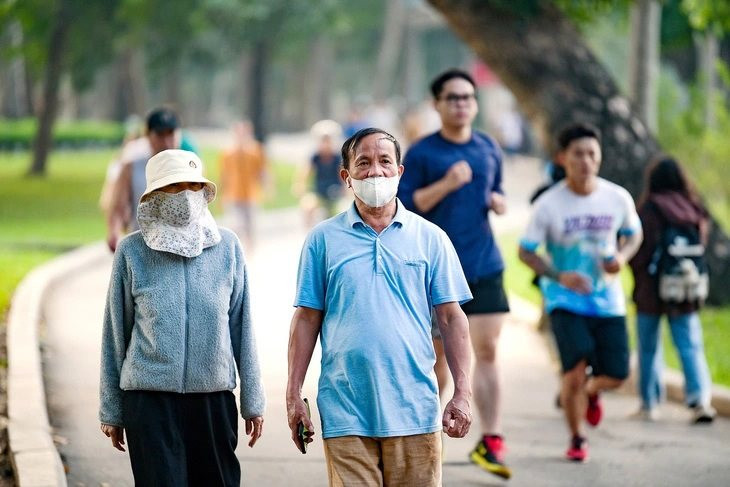Some northern localities are starting to get colder in the last months of the year. During this period, respiratory diseases become more complicated.

However, the change in weather does not mean we have to put off exercising during the cold season.
What should you prepare when exercising in winter? When the ambient temperature drops, accompanied by wind, the risk of being affected by adverse weather conditions is greater...
In developed countries, experienced runners will have experience in monitoring weather forecasts to decide what to prepare when winter comes.
In some forums, running enthusiasts also suggest that we should allow for an error of about 3 to 5 degrees Celsius, depending on whether it is windy or not that day.
Thanks to the advanced technologies of winter sportswear, it is possible to run outdoors while still keeping the body warm.
In cold weather, you should pay attention to covering your head, ears, neck, hands and feet. You should choose hats made of fabric that absorb sweat well to keep you warm and keep your hair dry.
Types of hats that can be used include wool hats or fleece hats combined with earmuffs to keep the head warm when running. On windy days, if you want to run, you can use a thin scarf to keep the neck warm without making the neck too hot during the run.
In addition, low ambient temperatures can cause chapped and damaged lips and nasal mucosa. When jogging, the frequency of inhaling through the nose and exhaling through the mouth is higher, so the cold air will enter the nasal mucosa and lips significantly more. Therefore, we should use lip balm to avoid chapped lips.
In addition, readers should use a mask to make the air flow into the nasal mucosa less cold, avoiding other harmful outdoor agents such as vehicle exhaust and cigarette smoke. The biggest disadvantage of masks is that they cause a feeling of "suffocation" because when exercising, the body needs a large amount of oxygen-carrying air.
Hands are also an important area that needs to be kept warm, especially on cold, windy days. There are two ways to protect your hands: wear fingerless gloves or wear full-gloves (that is, gloves that cover the entire hand).
Each type of glove has its own advantages and disadvantages. If we want to use the phone during breaks, fingerless gloves are the best choice, both sweat-absorbent and flexible. However, in terms of warming effect, fingerless gloves are not as good as hand covers, because hand covers will help the fingers to share the warmth with each other. In return, for those who sweat a lot, hand covers can cause discomfort during running.
The best way to keep warm when running in cold weather is to wear layers of clothing. These layers not only help retain heat but also absorb sweat through the layers well, preventing overheating while running.
When choosing clothes, you should wear sweat-absorbent shirts underneath. In Vietnam's climate, we may only need to wear two layers of clothing.
Some small notes when choosing a warm shirt: the base layer (innermost layer) should be made from synthetic absorbent materials. Do not choose cotton fabrics because they retain water, so when the shirt absorbs sweat, your body will also get wet.
The second layer should be insulated, such as fleece or goose down. Nowadays, sportswear has many types of lightweight goose down that do not restrict shoulder and arm movement when running.
This layer will retain some air to keep the body warm, but still ensure ventilation and allow moisture to escape.
The lower body from the buttocks down may not need many layers, as this area generates the most heat during running. You may only need to wear leggings or regular running pants, as long as they meet the sweat-wicking factor.
On windy days, a second layer may be considered, but in most cases in our climate this is not necessary.
Keeping your feet warm is often overlooked by runners because they think that wearing running shoes is a way to keep warm. However, if you pay close attention, you will realize that running shoe manufacturers design running shoes for different types of running and different seasons.
For example, marathon running shoes will have a different design and fabric than speed running shoes. On cold days, we should choose shoes with as little mesh as possible to limit cold air and water from the road surface from penetrating the feet.
Besides, runners do not forget to wear socks that absorb sweat well, because if they do not absorb sweat well, our feet can easily get blisters.
Regardless of whether you are running in hot or cold weather, planning your run is essential. Unlike running in hot weather, in cold weather, runners must prepare a lot of clothes and know how to use thermal clothing properly.
In addition, practitioners need to pay attention to breathing rhythm and breathing method. In people with a history of asthma, sudden inhalation of cold air can cause the airways to constrict and cause an asthma attack. For those with underlying diseases, the best option is to switch to indoor training at the end of the year.
According to Tuoi Tre